The Nationa Museum of Bargello in Florence
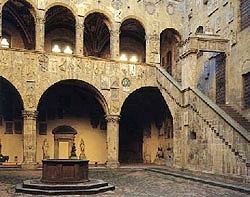
Firenze - Bargello
The National Museum has its setting in one of the oldest buildings in Florence that dates back to 1255. Initially the headquarters of the Capitano del Popolo (Captain of the People) and later of the Podesta, the palace became, in the sixteenth century, the residence of the Bargello that is of the head of the police (from which the palace takes its name) and was used as prison during the whole 18th century. Its walls witnessed important episodes of civic history. It was the meeting place of the Council of the Hundred in which Dante took part. It witnessed sieges, fires, executions, the most famous perhaps being that of Baroncelli, involved in the Pazzi plot against the Medici, which Leonardo also witnessed. During the 14th and 15th century, the palace was subjected to a series of alterations and additions, still preserving its harmonious severity, best seen in the beautiful courtyard, the balcony and the large hall on the first floor. The building`s use as National Museum began in the mid-19th century. Today it is the setting for works of sculpture, mainly from the grand ducal collections, and for many examples of "minor" Gothic decorative arts. The large 14th century hall on the first floor displays some works by Donatello (1386-1466) including the early marble David), the St. George moved to this location from the niche in Orsammichele, the more mature and ambiguous bronze David, the Aty and the Marzocco, originally installed on the battlements of Palazzo Vecchio.
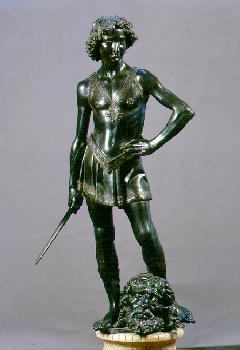
The works of the master are surrounded by the most delicate works of his pupils Desiderio da Settignano (c. 1430-1464) and Antonio Rossellino (c. 1427-1479). The collection also includes the two panels entered by Lorenzo Ghiberti and Filippo Brunelleschi for the Baptistery door competition of 1401. The Renaissance repertoire comprises the glazed terracottas by Luca della Robbia (c.1400 -1482) that include a very extraordinary group of Madonna with Child. The rooms on the ground floor exhibit Tuscan 16th century works, focusing in particular on four masterpieces by Michelangelo (1475-1564): Bacchus, the relief representing a Madonna with Child, Brutiu and David-Apol). The assortment is then followed by works of Andrea Sansovino (1460-1529), Jacopo Sansovino (1486-1570), Baccio Bandinelli (1488-1560), Bartolomeo Ammannati (1511-1592), Benvenuto Cellini (the model of Perseus and the small bronze sculptures were moved to this location from the Loggia dell`Orcagna), down to Giambologna (1529-1608) with his admirable Mercury. The bronze animals that were originally placed in the grotto of the Medici villa of Castello are now displayed on the staircases. The museum stores however many other treasures: fine works of art enriched by the Carrand, Ressman and Franchetti collections comprising decorative or "minor" arts are distributed among the several rooms of the Palace, both on the first and second floor. From ivories that include several Roman and Byzantine examples, down to medieval glazes and Limoges porcelain; from German and French gold works, Renaissance jewels down to Islamic examples of damascened bronze; from grand ducal collections down to Venetian glass. The museum displays several treasures including very unique panel pieces and wooden sculptures. Of note are also the majolicas, arms and small bronze statues. Two rooms on the second floor are dedicated to the glazed terracottas created by Andrea and Giovanni Delia Robbia, besides displaying the bronze David and the Lady with Posy by Verrocchio in the room named after the artist, which displays also an extraordinary collection of busts of Florentine personalities made by some of the most important 15th century artists. One of the most important sculptures is the portrait of Costanza Buonarelli by GianLorenzo Bernini. It is also worth visiting the very lavish collection of medals belonging to the Medici family....from Museums and Galleries of Florence and surroundings ( Apt - Florence )
Bargello ... read more ..
Bargello
Our most requested apartments in the Florence historical centre:
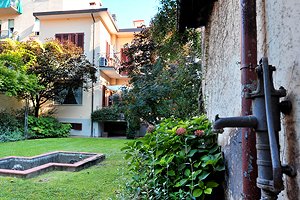 Holiday apartments in pretty villa on the southern outskirts of Florence, in the vicinity of Piazzale Michelangelo. Accommodation for groups of 4/6/8/10/12 people. Air conditioning, Internet connection. Just a few minutes from Florence historical centre.
More details
Holiday apartments in pretty villa on the southern outskirts of Florence, in the vicinity of Piazzale Michelangelo. Accommodation for groups of 4/6/8/10/12 people. Air conditioning, Internet connection. Just a few minutes from Florence historical centre.
More details
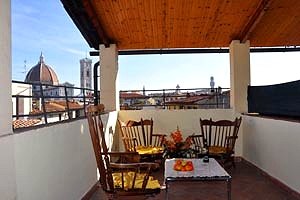 Beautiful apartment sleeping 6+2 in Florence historic centre, at a stone`s throw from Santa Maria Novella railway station. Air conditioning, Internet connection and panoramic balcony with view over the Duomo and the Medici Chapels.
More details
Beautiful apartment sleeping 6+2 in Florence historic centre, at a stone`s throw from Santa Maria Novella railway station. Air conditioning, Internet connection and panoramic balcony with view over the Duomo and the Medici Chapels.
More details
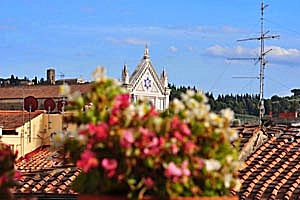 Apartment sleeping 2+1 in the heart of Florence historic centre, in the district of Santa Croce. Panoramic balcony with view over the basilica of Santa Croce, air conditioning, Internet connection, close to the most important Florentine monuments.
More details
Apartment sleeping 2+1 in the heart of Florence historic centre, in the district of Santa Croce. Panoramic balcony with view over the basilica of Santa Croce, air conditioning, Internet connection, close to the most important Florentine monuments.
More details
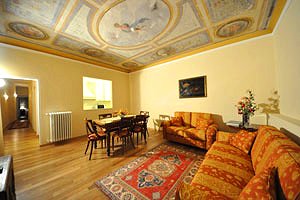 Apartment in the historical centre of Florence a few steps away from the Accademia Gallery. Nearby Piazza Duomo, Piazza Signoria, the Uffizi Gallery . 5+2 beds, Internet Connection and air conditioning.
More details
Apartment in the historical centre of Florence a few steps away from the Accademia Gallery. Nearby Piazza Duomo, Piazza Signoria, the Uffizi Gallery . 5+2 beds, Internet Connection and air conditioning.
More details


 Holiday apartments in pretty villa on the southern outskirts of Florence, in the vicinity of Piazzale Michelangelo. Accommodation for groups of 4/6/8/10/12 people. Air conditioning, Internet connection. Just a few minutes from Florence historical centre.
More details
Holiday apartments in pretty villa on the southern outskirts of Florence, in the vicinity of Piazzale Michelangelo. Accommodation for groups of 4/6/8/10/12 people. Air conditioning, Internet connection. Just a few minutes from Florence historical centre.
More details
 Beautiful apartment sleeping 6+2 in Florence historic centre, at a stone`s throw from Santa Maria Novella railway station. Air conditioning, Internet connection and panoramic balcony with view over the Duomo and the Medici Chapels.
More details
Beautiful apartment sleeping 6+2 in Florence historic centre, at a stone`s throw from Santa Maria Novella railway station. Air conditioning, Internet connection and panoramic balcony with view over the Duomo and the Medici Chapels.
More details
 Apartment sleeping 2+1 in the heart of Florence historic centre, in the district of Santa Croce. Panoramic balcony with view over the basilica of Santa Croce, air conditioning, Internet connection, close to the most important Florentine monuments.
More details
Apartment sleeping 2+1 in the heart of Florence historic centre, in the district of Santa Croce. Panoramic balcony with view over the basilica of Santa Croce, air conditioning, Internet connection, close to the most important Florentine monuments.
More details
 Apartment in the historical centre of Florence a few steps away from the Accademia Gallery. Nearby Piazza Duomo, Piazza Signoria, the Uffizi Gallery . 5+2 beds, Internet Connection and air conditioning.
More details
Apartment in the historical centre of Florence a few steps away from the Accademia Gallery. Nearby Piazza Duomo, Piazza Signoria, the Uffizi Gallery . 5+2 beds, Internet Connection and air conditioning.
More details







